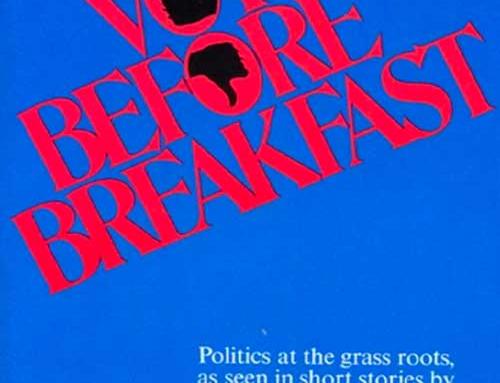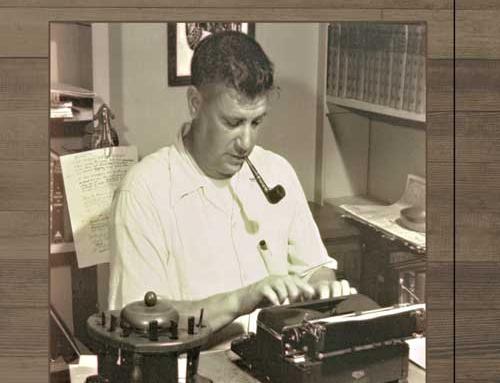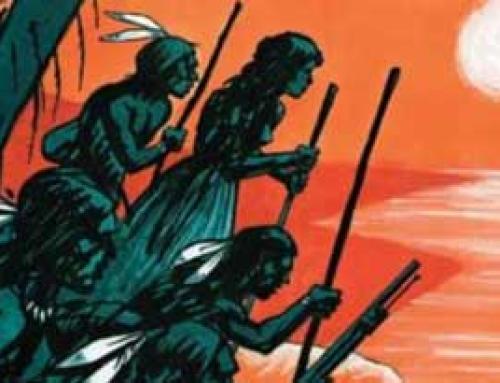“A perfect woman, nobly planned . . .”
—William Wordsworth
Jesse Stuart and Naomi Deane Norris met as Greenup High School students in the mid-1920s. When Deane saw Jesse, a “timid-looking new boy from the country,” she was unimpressed with his patched sweaters and rough accent. There was no hint whatsoever of their future romance.1 Despite their vast differences, though, they found themselves seriously dating within a decade.
Jesse was a farmer’s son, a prolific poet, a hunter, and a shepherd. The people of Greenup regarded him distantly and with great distrust: his ideas were too radical and his aspirations too great. When Deane’s parents, Myrtle and Emmet Norris, saw the “pouting poet of W-Hollow” approach their doorstep wearing muddy boots, holding a bouquet of wildflowers, and packing two pistols in his back pocket, they must have worried about their oldest daughter’s romantic choice.
In 1920, Emmet and Myrtle had moved from Hopewell—where they had lived since Deane was born in 1908—to the city of Greenup. Emmet wanted his six children to receive a better education than they would have experienced in the country schools back home, so he moved to town to become an engineer for the C&O Railway. Later, because he was blind in one eye, he worked as a shipping clerk at the Greenup Milling Company. He and Myrtle shared an inheritance of hard work and conservatism with Deane. For years, she gave them no cause for concern, graduating in 1928 as salutatorian of her high school class and becoming an outstanding second-grade teacher. During summers, she supplemented her education with classes at nearby Morehead Normal College. There, her biggest adventures ranged from socializing over pimento cheese sandwiches at Battson’s Drug Store to listening to big band music in the basement of Fields Hall with her best friend and roommate, Selma McClain Allen.2 Deane always remembered these summers as among the best times of her life, but she longed to experience more.3 She earned her bachelor’s degree in 1938—a year before marrying Jesse and getting her wish for a more exciting life.
Deane, a caring, empathetic teacher, was deeply involved in the community. In the years Jesse was away at college, she spent most of her time taking part in social clubs and working on lesson plans. She considered herself “usually quite serious” but could be lighthearted, especially with her second-graders. She confessed to Jesse, “You know sometimes the teacher even enjoys a little game of jacks or a ‘turn’ at rope jumping.”4 On the whole, she loved her job. Whenever her principal, Mr. Nickel, asked her to do anything, she immediately agreed—whether it was following convoluted school protocol or training fourteen seven-year-olds to do a May Pole dance in less than three days. Deane enjoyed pleasing him and respected his direction.5
It posed a problem then when Mr. Nickel forbade Jesse Stuart to set foot on his school’s property. The men intensely disliked each other. They differed on educational policies and clashed whenever they spoke. When Jesse returned from studying in Nashville in the early 1930s, he took various positions with Greenup schools, trying his hand at principal, superintendent, and teacher. From 1931 until 1936, he was informally engaged to Elizabeth Hale, a Nashville teacher and Grand Ole Opry star. Nevertheless, he courted Deane when he was in town. She felt that her friendship with Jesse and her popularity in “Mr. Nickel’s school system” were equally important, so she had a major decision to make: would she allow Jesse to walk her to school?6 She ultimately defied her principal, and Jesse could often be seen covertly walking arm-in-arm with her around the school property.7
While Jesse was informally engaged to Elizabeth, his dates with Deane remained platonic, but some were undeniably tinged with romance. When he published his first book, Man with a Bull-Tongue Plow, in 1934, he and his “best friend” Naomi Deane Norris read the sonnets together, with soft music playing in the background.8 Although the book was dedicated to his fiancée, several sonnets were about the “beautiful and queenly” Jean Torris.9 After Elizabeth ended their engagement, Jesse and Deane grew closer. Deane’s diary was a catalogue of what Jesse had done or said recently. Other young men cropped up from time to time as dance or lab partners, but they were sandwiched between Jesse’s news and never earned a second thought from Naomi Deane Norris.10
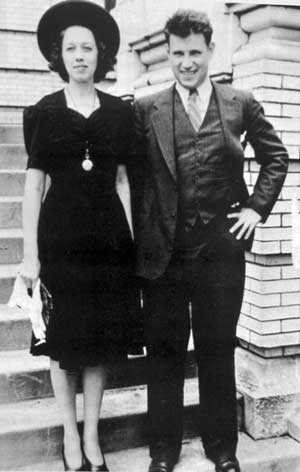
Jesse Stuart married Naomi Deane Norris in the winter of 1939.
From June 1937 to July 1938, Jesse lived in Scotland and toured the rest of Europe on a Guggenheim fellowship. He sent Deane scarves, candy, and Dutch tulips, and she sent him cigars. They also exchanged letters and clippings about his publications. His schedule was crammed with visits, travels, and dates with beautiful girls whose pictures he sent to just about everyone but Deane; her evenings and weekends were busy with dances and trips to Cincinnati. Her days were still all about her students, whose daily dramas she detailed for Jesse, along with those of their own friends. Both Jesse and Deane were leading full and complex lives. When people teased her about not having any dates or when she overheard criticism of Jesse’s books, though, Deane would get “a bad case of the blues.”11
Although they frequently expressed their affection for each other, Deane was afraid that her letters were “very uninteresting” compared to exotic surroundings such as Paris or Prague.12 She suffered frequent bouts of worry and self-doubt and constantly apologized for not being articulate or literate enough. In her appraisal of Jesse’s new autobiography, Beyond Dark Hills, she concluded by saying, “Maybe I haven’t said what you would like me to say. Maybe I cannot say what I would like to say.”13 Despite her concerns, Jesse enjoyed their correspondence and sent her to visit his parents’ farm in the spring, when the hills would be in bloom.14 She agreed and thanked him for making nature seem relevant to her.
When Jesse returned from Europe, Deane was among a large delegation of friends that met him at the train station. That same evening, at the home of Oscar and Ann Sammons, they drank wine, played records, and caught up on the news. Thus began a year of regular dating. Deane’s diary reports that she had “a very, very nice time” going places with Jesse, sharing coffee and conversation, enjoying cokes and hamburgers, visiting friends, and attending parties.15 Jesse “suddenly . . . realized that Naomi D. Norris was beautiful,” and they married fifteen months later.16 Although they had planned to marry in spring 1940, Jesse impulsively proposed on October 12, 1939, and they bought a marriage license that evening. Not wanting to “tempt fate” by marrying the next day, Friday the thirteenth, they waited until the early morning of Saturday, October 14, 1939, to take their license to the Reverend Frank Richardson. After the ceremony, the newlyweds returned to their separate homes and kept their union a secret for a month before Deane told her parents.17
They could not announce their marriage immediately for several reasons. Deane was leery of drawing attention away from her sister Nancy, who had her own large wedding planned for the next day, October 15. Money was another issue. Jesse had to sell a poem just to purchase the marriage license. They also needed Deane’s teaching salary, and married women were not permitted to teach in those days.18 (Eventually, Deane did quit on her own but said it was because Jesse did not “get along well when [she was] out of the home.”19) When E. P. Dutton accepted Jesse’s first novel, Trees of Heaven, for publication a month later, the couple finally announced their union and honeymooned in New York on an advanced payment against royalty earnings.20
That winter, they lived with the Norrises and later boarded in Fullerton for three months. On Deane’s 32nd birthday, April 16, they took a picnic lunch out to W-Hollow. When they sat down to eat, she suggested making a home there by restoring an old barn, one of Jesse’s childhood homes. While Jesse was elated, he was hesitant to set up his official marriage bedroom in the same room where his younger brother had died of pneumonia. It was Deane who convinced him, saying, “Jesse, we’ll make this a happy place.”21 He knew she was right. He had prepared himself “to go out [of the hollow] for her sake, if that was what she wanted,” but his heart’s desire lay in the soil that had always nourished him. So did Deane’s. They set about making a happy home.22
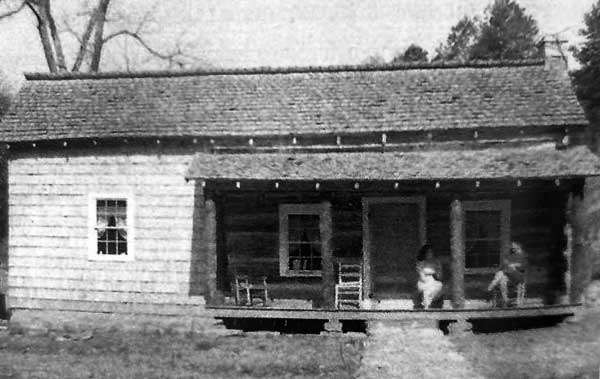
In 1940, Jesse and Naomi moved into the home where Jesse had grown up following a renovation and expansion. It would be their forever home.
By fall, they had transformed the old barn into a four-room house with low ceilings and wrought-iron fixtures.23 Jesse told Deane to fix up the house however she liked. He noted that he would be “second when it comes to the house” but “out on the farm,” he would be first. “I know how to handle land,” he told her confidently. “I’ll run the farm, and you run the house.”24
As far as décor, he had only three requests: white woodwork, wallpaper (as opposed to painted walls), and white ruffled curtains.25 Deane furnished her home expertly, melding local and exotic themes. As the years passed, they acquired souvenirs from forty-eight countries, while the walls were adorned with the old-fashioned hooked rugs Deane made. Pictures, awards, and Jesse’s books were scattered everywhere. The atmosphere was rustic and peaceful. Journalist Shirley Williams later described the home as a “tasteful and pleasant place” with the “gleam of old wood and brass.”26
Jesse needed Deane, however, for more than interior design. She was his best critic and editor, suggesting titles, typing manuscripts, and correcting his poor spelling. “She goes over everything I write,” he said, “. . . every poem, story, and manuscript.” It was often her input that elevated Jesse’s writing to a publishable caliber.27
In the early years of their marriage, Jesse was trying to write a novelette to boost their slim finances. After showing Deane a draft just before midnight one New Year’s Eve, she read it and declared, “This is not a novelette. It’s a book.” The book became Taps For Private Tussie, a best seller, which Deane edited, before and after it was typed, and checked the galley proofs. It became a Book of the Month Club selection. 28
She was thoroughly devoted to his work. Jesse once composed her a love poem during a walk, and she willingly turned around and offered up her back as a writing table. Jesse thoughtfully dedicated such poems to her. She also had the challenging task of handling the throngs of uninvited and unexpected fans that came to W-Hollow, although she insisted that “[o]nly the finest and the greatest [people] have come to see us.”29
For Jesse to have been the host of such impromptu gatherings would have been a disaster. With Deane at the helm, things ran smoothly. While Jesse appreciated her help tremendously, he occasionally teased her about her proper ways. In a letter to their friends the Voierses, he drew a sketch titled “Poppie Gus telling the joke about Mr. Grummond’s being at the undertakers.” Surrounding Gus Voiers were his wife (“trying to control [him] regarding such jokes”), “Old Stuart roaring with laughter,” and Deane, labeled in Jesse’s nearly illegible hand as “prim and precise wanting to laugh but won’t turn loose.” 30
But Deane did turn loose, in her own way. When the Stuarts were living in Egypt, she said that their only child, Jane, and her husband had “written much of our experiences here,” but that she was sure hers “surpasse[d] theirs.” She followed with a lovely letter full of insightful observations and anecdotes about the students she had taught for “two unforgettable weeks” in Maadi, a suburb outside Cairo.31 As her best friend, Ethel McBrayer, put it, “Deane always made the best of everything.”32
The Stuarts did not slow down as they entered their later years. With Jane out of the house, they had more time for writing, traveling, and lecturing. By the late 1970s, Jesse’s grueling pace had exacerbated his health problems. A series of strokes and heart attacks left him increasingly weak until his death in 1984. Deane, her health undermined by the constant stress of caring for her failing husband, suffered a stroke on her left side while doing housework in 1986. Despite her condition, she refused to go to the hospital until the old shoes on her feet had been replaced with a nicer pair.33
Deane spent much of 1987 in a health care facility in Florida, near Jane. Her few visitors saw that she was sad and lonely and missed W-Hollow. On December 30, 1987, the “two baby sisters”—Jesse’s youngest sister, Glennis Stuart Liles, and Deane’s youngest sister, Laura Avanelle Callihan—brought her back to W-Hollow. “They saved my life,” Deane often said.
For five-and-a-half more years, she enjoyed the familiar surroundings of her lifelong home and the company of family and friends who loved her dearly. After sufficiently recovering from her stroke, she returned to her old routines: going to church every Sunday, eating at Greenbo State Park’s Jesse Stuart Lodge or at the Chimney Corner Restaurant in Ashland, and getting her hair done at the Ashland Beauty Shop.34 After Jesse died, she had more time to cultivate relationships with friends. In the past, the Stuarts had been so busy that they had amassed “mountains of acquaintances, but few close friends.”34
Deane Norris Stuart died peacefully at King’s Daughters Hospital in Ashland on June 22, 1993, at age 85. Until the end, she was working regularly and enthusiastically with staff from the Jesse Stuart Foundation to ensure her late husband’s legacy.
When asked once if she believed that behind every great man is a great woman, Deane did not skip a beat. “Yes,” she answered. “His mother was behind Jesse. She was a remarkable woman.”36
Such modesty about her own contributions to Stuart’s life and career may have led some to believe that she was overly devoted to her home, her husband, and the work they shared. In his essay “Feminism, the Body, and the Machine,” Wendell Berry writes about critics who assume that a woman who works inside her home, rather than outside, is a “drudge, exploited by a conventional subservience.” Berry categorically rejects the idea that working outside the home somehow confers more dignity, upon a man or a woman, than striving to strengthen the family. In its healthiest and most productive form, marriage is “a state of mutual help,” but in today’s world, many see it as the pairing of two totally independent individuals whose “rights and interests must be constantly asserted and defended.” Deane and Jesse did not see their marriage in those terms. They understood “themselves as belonging to their marriage, to each other, and to their [child].”37
Theirs was a functional relationship—respectful, efficient, and loving—which allowed Jesse and Deane to benefit from each other’s positive qualities and skills. Toward the end of her life, Deane declared to an interviewer that she was “liberated.” What she had with her husband was not shackling or restrictive, but empowering.37
…
Deane Norris you and I have gone together,
we walked together when the moon was full;
when winds were sobbing in the mountain heather—
Deane Norris, you were straight and beautiful,
and I was proud to walk beside of you.
You were as pretty as a willow tree
when its sharp leaves turn silver in the wind.
We have gone out and danced the night together—
swinging to the rhythms of the violin—
you neatly patterned as a willow tree,
your auburn hair so naturally was curled
with softness of a blossom first unfurled,
your eyes were dew-drops in the early morn
the sun left hanging to the blades of corn.
“To Call Our Own”
A little piece of earth to call our own,
This little house that we have made together,
An open fire with seasoned wood to burn
To give us warmth against the winter weather
Are life securities we understand.
We know the strength and nature of earth’s crust
Where we grow sustenance with our own hand;
Meadows we made and love and fondly trust
Give us soft flowering beauty in the spring
And long windrows of summer-scented hay.
Above our wheat the yellow finches sing
And pollinated wind corn tassels sway.
Dollars lose value, but our land will never
Where yellow finches sing for wheat-grain fee,
Where seasons come and live, then die forever
And sheets of honey-colored wind blow free.1
ENDNOTES
- Lochie B. Hart, “A Profile of Naomi Deane Stuart,” from The Sixth Summer of the Jesse Stuart Creative Writing Workshop at Murray State University, 1976, 209-214.
- Helen Price Stacy, “Mrs. Jesse Stuart Looks Back on Life,” Jesse Stuart Foundation (JSF) archive material, undated.
- Naomi Deane Norris to Jesse Stuart, January 6, 1938.
- Naomi Deane Stuart to Jesse Stuart, February 18, 1938, and February 13, 1938.
- Naomi Deane Stuart to Jesse Stuart, April 28, 1938.
- Naomi Deane Stuart to Jesse Stuart, January 6, 1938.
- Hart, 209.
- James M. Gifford, “Mrs. Stuart was loving companion, valued editor,” Ashland Daily Independent, June 24, 1993; Mae Dittbenner Dixon, “Jesse Stuart and Education,” unpublished master’s thesis, Western Kentucky University, July 1952, 36.
- Jesse was no master of disguise or subtlety. In his short stories, Deane progressed from being “Jean Torris” to “Deanems.”
- See Naomi Deane Norris’s diaries for June 26-28, 1938, and June 22, 1937.
- Naomi Deane Norris to Jesse Stuart, February 18, 1938.
- Naomi Deane Norris to Jesse Stuart, May 26, 1938.
- Naomi Deane Norris to Jesse Stuart, May 10, 1938.
- Naomi Deane Norris to Jesse Stuart, March 13, 1938.
- Naomi Deane Norris’s diary, August 6, 1938.
- See, for example, Dick Perry, Reflections of Jesse Stuart (New York: McGraw Hill, 1971), 41.
- Ibid; Dixon, 3.
- Hart, 210.
- Mildred Aukerman, “A Glimpse at Naomi Deane Stuart,” from the Sixth Summer of the Jesse Stuart Creative Writing Workshop at Murray State University, 1976, 209-214.
- Hart, 211.
- Andy Mead, “There’s Hope in W-Hollow,” Lexington Herald Leader, January 10, 1983.
- Perry, 44.
- Ibid; Aukerman, 211.
- Perry, 44.
- Aukerman, 212.
- Shirley Williams, “Jesse Stuart: A Kentucky Writer with a zest for life and letters at 70 despite setbacks,” Louisville Courier Magazine, August 7, 1977.
- James M. Gifford, “Mrs. Stuart was loving companion, valued editor,” Ashland Daily Independent, June 24, 1993.
- See my Introduction to Jesse Stuart, Taps for Private Tussie (Ashland, Kentucky: Jesse Sturt Foundation, 1992), especially pp. Ix and x.
- Aukerman, 212-213.
- Jesse Stuart to Lena Wells Voiers, December 21, 1958.
- Naomi Deane Stuart to Lena Wells & Gus Voiers, October 2, 1960.
- Ethel McBrayer notes, JSF Archive material, undated.
- G. Sam Piatt, “Naomi Deane, widow of Jesse Stuart, in guarded condition following stroke,” Ashland Daily Independent, September 24, 1986.
- Helen Price Stacy, “Mrs. Jesse Stuart Looks Back on Life,” JSF Archive material. See also James M. Gifford, “Mrs. Stuart was loving companion, valued editor,” Ashland Daily Independent, June 24, 1993; Naomi Deane Stuart to Margaret Lynd, March 24, 1988.
- Ethel McBrayer notes, JSF Archive material.
- Aukerman, 214.
- Wendell Berry, “Feminism, the Body, and the Machine,” What Are People For? (San Francisco: North Point Press, 1990), 178-196.
- G. Sam Piatt, “Naomi Deane, widow of Jesse Stuart, in guarded condition following stroke,” Ashland Daily Independent, September 24, 1986.
Poem —To Call Our Own.
- Jesse Stuart, Kentucky Is My Land (Ashland, Kentucky: Jesse Stuart Foundation, 1992), 39.
By James M. Gifford
JSF CEO & Senior Editor
Beginning in 1937, a new book had been tumbling around in Jesse Stuart’s head. It was a book about education—a personal testimony to the teaching profession. In 1948, he finished the book, and it was published the following year.
“The Thread That Runs So True,” a classic of educational philosophy and educational history, is treasured by teachers throughout the world. It is the autobiographical story of Jesse Stuart’s first teaching experience in a dilapidated one-room school structure in Greenup County. Some of his pupils were older and bigger than he was, and discipline occasionally led to frightening confrontations, like Stuart’s famous fight with Guy Hawkins.
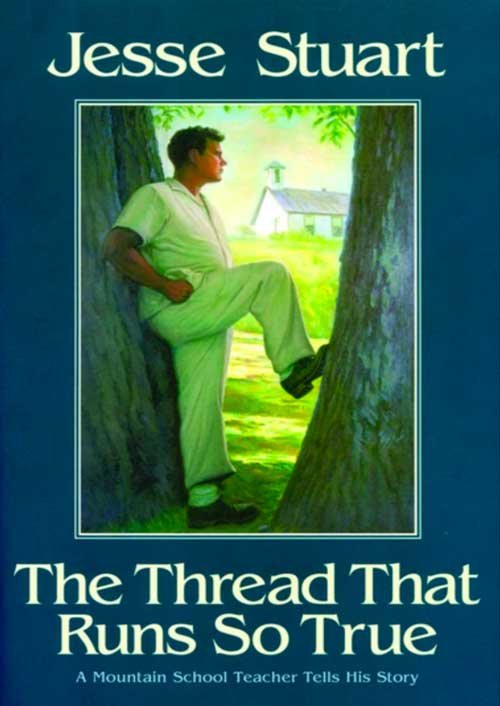
This book has inspired many young people to become teachers, and it has encouraged many teachers to remain in the profession. With eloquence and wit, Stuart traces his educational career, which began when he was teaching grades one through eight in a one-room school. Soon afterwards, Stuart became a principal and finally superintendent of city and county schools. The road was not smooth, however, and Stuart faced challenges from students, distrustful parents, and uncooperative administrators. Through it all, Stuart never lost his abiding faith in the power of education. Jesse Stuart’s “The Thread That Runs So True” is timeless proof that “good teaching is forever and the teacher is immortal.”
When “Thread” was first published in 1949, reviewers quickly realized the impact this book would have on teachers. For example, Dr. Jay Elmer Morgan, President of the National Education Association, called it “the best book on education written in the last fifty years.” This book began with a good sale; sales have continued each year, and it remains in print today. Its readers mailed thousands and thousands of letters of thanks and praise to Stuart. The conviction, sincerity, and energy of this book accounts for its enduring appeal in our current world of cynicism and despair.
Jesse Stuart explained, “I wrote it because in my early teaching years, I learned that the teaching profession is the greatest profession in the world since all other professions stem from it . . . I wrote this book in praise of our teachers and pupils, and our schools in America.” For Kentuckians and for rural schoolteachers throughout America, this story of a young teacher’s experience has a special meaning and value.
“The Thread That Runs So True” is not fiction as so many of its readers have believed. Teachers recognized immediately that “Thread” is a factual book, because they have had similar experiences. Many parents and general readers have never doubted its authenticity because they attended schools similar to those described in “The Thread That Runs So True.” “You might say,” said the author, “that it is ninety-nine percent truth and, perhaps, one percent fiction; it is as authentic as apple pie, a tree, a stone, or a star.”
In 2006, the Jesse Stuart Foundation published a special hardback edition of “The Thread That Runs So True” to celebrate Jesse Stuart’s 100th birthday. Hardback and softback copies are available at the Jesse Stuart Foundation Bookstore at 4440 13th Street in Ashland. For more information, call 606-326-1667 or email jsf@jsfbooks.com.
By James M. Gifford
JSF CEO & Senior Editor


